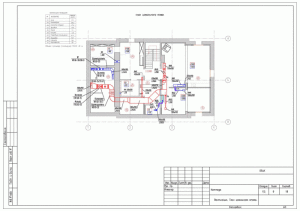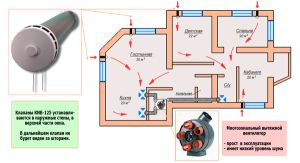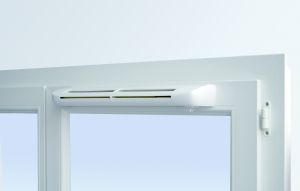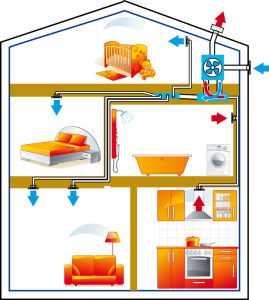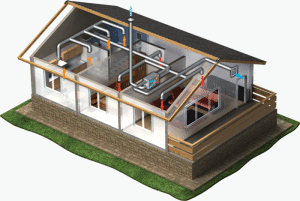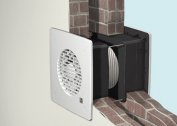The ventilation system in the cottage is necessary even if there is a forest or a clear field, a river and no industrial giants around, and the house itself was built from natural "breathing" materials.
Depending on the size and architectural features of the cottage, the ventilation project can be based on natural traction or mechanical. What is the ventilation system of the cottage and is it possible to assemble it with your own hands?
Design and types of ventilation of cottages
When designing ventilation for a cottage, the area, the purpose of the premises, the geographical location and the mode of use of the building are taken into account. The fundamental difference between the ventilation scheme of the cottage from the apartment in lightweight outdoor air filtration systems. In addition, designing a cottage, you can immediately provide for the installation of ventilation shafts.
In cottages with their own hands, you can equip one of three types of ventilation:
- forced-air and exhaust ventilation device of the cottage with natural draft;
- forced-air and exhaust air with forced draft, including energy-efficient with heat recovery;
- combined supply and exhaust.
We will talk about how to choose the right ventilation for your cottage and make it with your own hands.
Natural ventilation of the cottage
Natural ventilation in the cottage is the simplest, oldest and most widely used type of ventilation. The movement of air into and out of the house is due to the difference in pressure and air temperature in the street and inside. Traction intensity is influenced by wind direction, air temperature and atmospheric pressure.
With natural ventilation of the cottage, the air is drawn from the premises and replaced by street air. In order for this scheme to work effectively in modern conditions, it is necessary to ensure air flow.
In the original version, air entered through the cracks between the logs, in the window openings and under the doors. He stretched out through the chimney.
The technologies used in modern cottage construction make it possible to achieve almost complete tightness of the building. And stoves and fireplaces are far in every home. How to make ventilation in a cottage with plastic windows and a modern heating system?
Before you start arranging ventilation in the cottage, you should weigh all the pros and cons of the natural ventilation system for the cottage.
Pros:
- inexpensive equipment;
- simple installation;
- lack of costs during operation;
- works inaudibly.
Minuses:
- ventilation efficiency depends on weather conditions;
- in winter, cold air is supplied to the living quarters, that is, heating costs may increase;
- natural ventilation will not work if the house has a pool.
You will have to think about additional ventilation for the steam room.
Armed with knowledge, the owner himself can build such a ventilation system for the cottage with his own hands.
Airflow in the cottage
You can rely on vents and periodic ventilation. But high-quality natural ventilation of the cottage should provide constant air movement at a speed of no more than 0.2 meters per second. Therefore, special valves are installed for the inflow.
Window air inlets are integrated directly into the window frame. They let in a small amount of air sufficient for natural air exchange.At the same time, there is no draft in the house and the valve can be closed if it is very cold outside.
The same principle applies to wall inlet valves. These are pipes covered on two sides by bars. From the street, a muffler and sometimes a filter adjoin the grill. From the inside, the air duct is covered by an adjusting curtain, with the help of which the air flow is made larger, smaller or completely blocked.
Advanced intake valves for the cottage’s natural ventilation system automatically open and close. They work under the control of humidity sensors.
Air outflow
The cottage ventilation project is provided by air ducts, the outlets of which are located in the most “dirty” or wet parts of the house: a bathroom and a kitchen.
Inside the exits are covered with plastic grilles. The outer end of the pipe should extend 0.7 - 1 meter above the roof. Otherwise, you will not see good traction. The end of the exhaust duct of the cottage is covered with an umbrella from rain and snow. In two- or three-story cottages, ventilation will work better than in one-story cottages.
It is necessary to provide for ventilation shafts in advance, even at the stage of walling. It is advisable to order a cottage natural ventilation project for a professional, he will accurately calculate the width of ventilation ducts, the number of supply valves.
If the house is bought ready and the air exchange system is not provided for in it, the owner inevitably faces the question “how to arrange ventilation in the cottage?”. It’s necessary to break the interior decoration a bit, but even in a fully finished house you can find a place for exhaust ventilation ducts. The supply air valves for ventilation of the cottage with their own hands can be installed by the owner.
Combined ventilation of the cottage
The combined ventilation device of the cottage is natural, reinforced by technical means.
As a rule, the inflow is provided by the same valves. But the outflow of air is forced. When choosing fans, one should take into account not only power, but also noise performance. After all, if in a bustling city 20 decibels are completely invisible to residents, in nature they can create inconvenience.
Methods of organizing forced air exhaust:
- In a small cottage, it is enough to install an exhaust fan in each ventilation outlet (in the toilet and bathroom and in the kitchen). The kitchen is additionally arranged with a mechanical hood over the hob. You can install the simplest fans, which are turned on by a button or powered from the same line with the lighting. The light is on - the hood is working. There are models that work from presence sensors - there is a person in the room - the hood works. A serious minus of such a system is that there is no constant air exchange. It pulls only when the fans are on. The rest of the time, the operation of the system depends on the weather;
- Air ducts from the kitchen and bathrooms are collected in one ventilation duct, into which the fan is mounted. It is usually installed in the attic. There is also some additional ventilation equipment. Such a ventilation project for a cottage should be developed by a professional. It is important to choose the right fan power and supply the system with humidity sensors. Thus, everything happens as if by itself. A mechanical exhaust hood creates a vacuum in the house, which is compensated by the intake of fresh air through the supply valves.
When planning how to make ventilation in the cottage, you can choose another option. It is more expensive and difficult to install, but it provides the best conditions for residents.
This is a forced air flow, eliminating a significant drawback of the cottage’s natural ventilation system: supply of cold air.The supply equipment heats the clean street air with an electroten or a water heater and enters the living room at the optimum temperature. The stitched installation can be type-setting or monoblock. Air is distributed throughout the rooms through the ducts, and is supplied to the room by a diffuser in the ceiling or on the wall.
By increasing the pressure in the rooms, the exhaust air is simply "squeezed out" into the corridors, and from there into the ventilation ducts (kitchen and bathroom).
The air handling unit is not cheap, and even quite cumbersome. Large and comfortable cottages have a special room for equipment.
Supply and exhaust ventilation of the cottage
This is the most efficient cottage ventilation system. Only the specialists design the supply and exhaust ventilation system of the cottages. It is necessary to competently build a network of air ducts around the house, calculate their diameter, install additional equipment in the right places, and also select the fans. Therefore, it is necessary to design the ventilation of the cottage simultaneously with the design of the building itself.
With this ventilation scheme, filtered and heated (cooled) air enters the rooms and exhaust air is simultaneously drawn out. The main advantage of the supply and exhaust ventilation system is its automatic operation at specified parameters. In a cottage with a ventilation system, there is no need to condition the air.
The most modern systems are equipped with a recuperator, which allows the use of exhaust air heat to heat the supply air. A recuperator is a heat exchanger that receives heat from one air stream and transfers it to another. Due to the recovery of heat resources are saved, operating costs are reduced by an average of one third.
Ventilation of premises for various purposes in the cottage
Garage ventilation
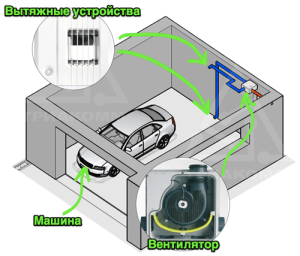
Exhaust gases, fumes of lubricants and fuel accumulate in the garage. In a certain concentration, they are dangerous to health and life. It is especially important to properly equip ventilation if the garage is located in the basement of the cottage or is attached close to it. A powerful forced hood is installed.
Kitchen ventilation
This is a room in need of enhanced ventilation. Vapors, smells of cooked foods and heat should not be distributed around the house. Therefore, an extract is made over the hob, and for the outflow of steam accumulations under the ceiling, an exhaust duct exit is equipped.
By the way, a mechanical kitchen hood can significantly change the movement of air flows and disrupt the ventilation of the house!
For more information on designing a cottage’s natural ventilation, consult a specialist.
Bathroom ventilation
In the wettest places of the cottage, natural ventilation is usually designed. Sometimes the air exchange is enhanced by forced draft - exhaust fans. According to the rules of exhaust ventilation equipment for cottages, air ducts from a toilet and a bathroom are not combined with air ducts from other rooms.
Pool ventilation
The abundance of constantly evaporating moisture requires intensive drawing. At the same time, it is necessary to maintain a comfortable air temperature. Therefore, such rooms in cottages are equipped with supply and exhaust ventilation systems, as well as air dryers.
Residential ventilation
For residential premises, it is enough to ensure a constant flow of fresh air from the street, which will displace used through the cracks in the door frames, under the interior doors. Therefore, when designing the ventilation of a cottage, one can restrict oneself to supply air valves or supply air ducts depending on the chosen air exchange system.
Basement ventilation of the cottage
The ground floor of the cottage can house workshops, a sauna, a swimming pool, a laundry, storage rooms. To create a normal microclimate, it is necessary to equip the ventilation of the basement floor of the cottage. It consists of ventilation ducts, as well as one or more air vents.
Be sure at the design stage of the cottage ventilation vents of the basement are provided. The number and area of vents depends on the size of the house, its location, topography, type of soil. See how to calculate them correctly.
Ventilation in the basement of the cottage is provided by a supply and exhaust system. It consists of two pipes: one air enters the basement, the other is drawn out. Pipes are installed vertically in opposite corners of the room. The outlet of the exhaust pipe should be 20-30 cm below the ceiling. And the supply air outlet is 20 cm above the floor. The exhaust pipe is displayed in the attic.
If the cottage is equipped with a fireplace, it is advisable to arrange the ventilation of the basement floor of the cottage near the chimney. This enhances traction.
Slider shutters are used to regulate the movement of air.
If the humidity in the basement is high and natural ventilation can not cope, a fan is installed in the exhaust pipe, forcibly removing moist and stale air.
